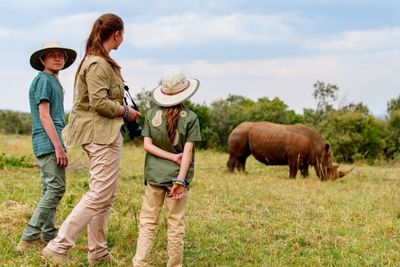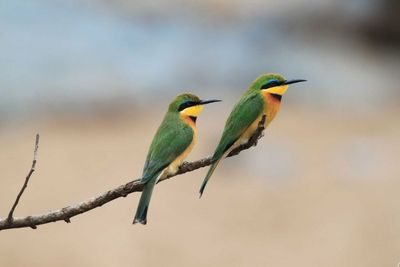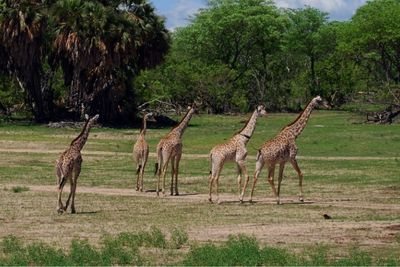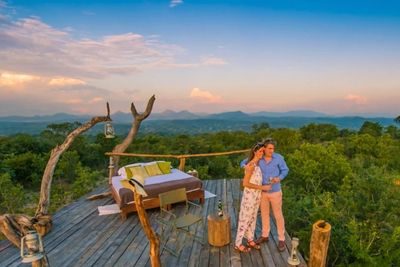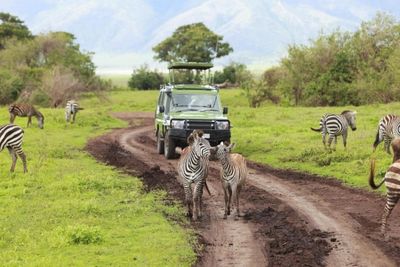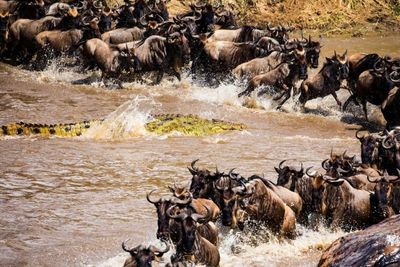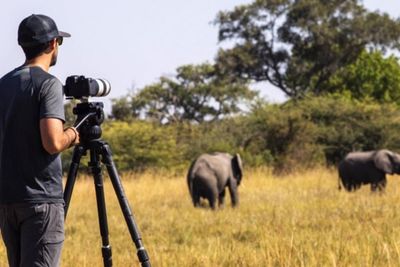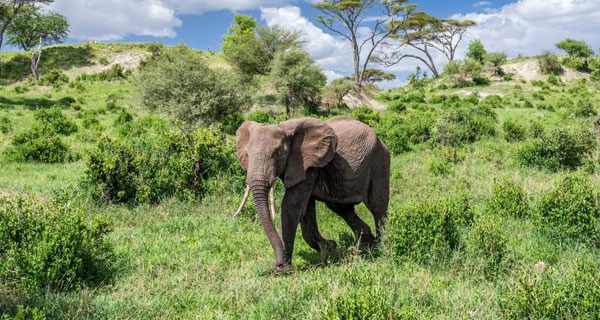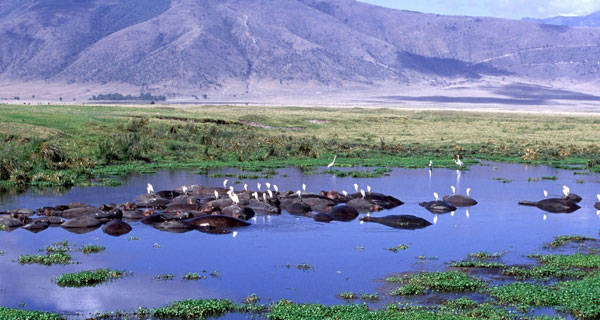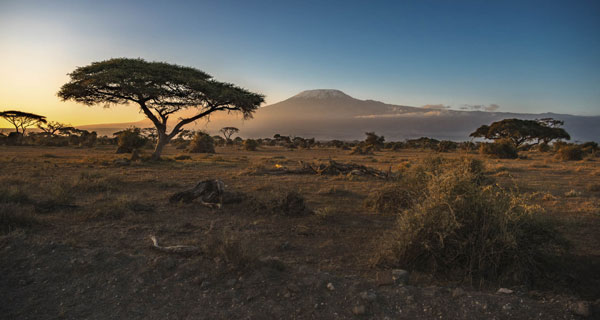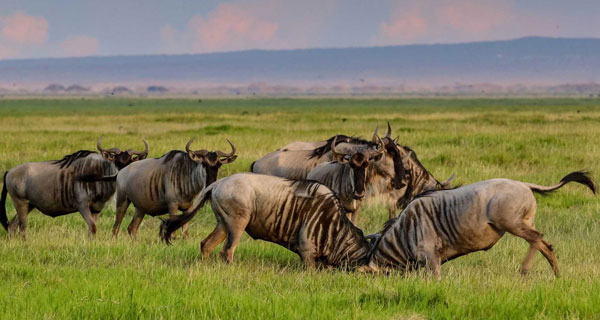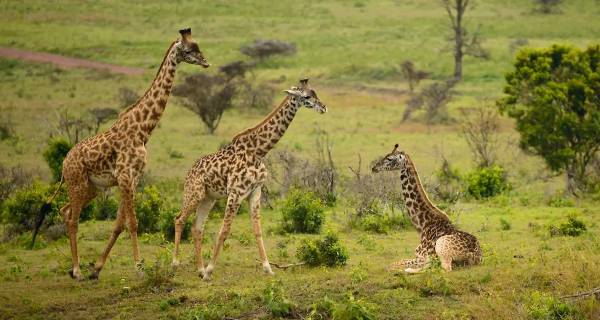Lake Manyara National Park is a hidden gem in Tanzania, perfect for an easy and diverse safari. Enjoy less crowded views of tree-climbing lions, vibrant flamingos, and lush forests. It’s an ideal spot for wildlife lovers and those seeking serene adventures.
Let's Plan Tanzania
Lake Manyara National Park
Lake Manyara, nestled at the base of the Great Rift Valley escarpment, is a scenic gem in northern Tanzania. Known for its tree-climbing lions, flocks of flamingos, and rich biodiversity, the national park offers unique safari experiences with lush groundwater forests, open plains, and the picturesque lake as a backdrop.
Discover Holidays to Lake Manyara
Lake Manyara National Park may be one of the smaller parks in Tanzania, but it captures the essence of the country’s vast landscapes within its compact borders.
Just a 90-minute drive from Arusha, this park is a convenient gateway to the wild, sandwiched between the popular destinations of Ngorongoro and Tarangire. The park features a rich mosaic of microclimates across its various terrains, from shimmering soda lake shores to dense acacia woodlands teeming with wildlife.
Here, you can witness tree-climbing lions adapting to their environment, elephants roaming in large, protective family groups, and a spectacular array of birds, from migratory flamingos to waders along the lake’s edge.
Each visit to Lake Manyara reveals something new, depending on the season: lush greenery welcomes herds of grazing animals, while drier times bring large mammals like elephants closer to view. A day’s exploration in Lake Manyara National Park as part of your Safari in Tanzania offers an immersive experience of the vibrant life cycles of this exceptional ecosystem, making it a must-see on any traveller’s itinerary.

Welcome to Tanzania! We’re excited to share our home with you. Every single day on a Safari in Tanzania is a delightful experience here. Travelling in the country provides sights that will awe and inspire you.
Juma Rajabu Sumbi
Managing Director
Why Visit Lake Manyara National Park?
Wildlife in Lake Manyara











Lake Manyara National Park in Tanzania is a super cool place for animal lovers. Did you know this park is famous for lions that climb trees? It’s pretty unusual to see lions up in branches, and nobody knows exactly why they do it. Some think it helps them stay away from bugs or lets them see prey better. A list of Lake Manyara Wildlife is as follows:
Big Cats
Keep your eyes peeled for lions up in trees, as well as sneaky leopards and majestic elephants around the park.
Elephants and Baboons
There are big groups of elephants here that are fun to watch. You’ll also find large troops of baboons hanging out together.
Other Animals
Look out for buffalos, zebras, and the tallest animal on Earth, the giraffe! You might also spot some tiny dik-dik antelopes.
Hippos
At one end of the park, there’s a special spot to watch hippos. You can see them playing or just chilling in the mud.
Birds Galore
If you like birds, you’re in luck! There are over 400 kinds of birds here, including flamingos and rare ones like the African hawk-eagle.
When you visit Lake Manyara National Park with us, every day is an adventure. You’ll get to see all sorts of animals doing amazing things, from lions in trees to hippos in the mud!
When to go to Lake Manyara
January
As the wet season peaks, January is a vibrant time at Lake Manyara National Park. The rains bring the landscape to life, turning it into a lush, green haven which is perfect for photography.
This is an excellent time for birdwatchers on Safaris in Tanzania to see migratory species, including vibrant flamingos, which add a splash of colour against the green.
Despite occasional showers, the park’s beauty and tranquil atmosphere make it a great month for a serene getaway.
February
February offers a continuation of the lush conditions at Lake Manyara, with dense greenery and abundant water attracting wildlife to the park’s many waterholes.
Game viewing is particularly rewarding as animals are easier to spot in the verdant landscape.
Bird life continues to thrive, making it a prime month for Best Safari Tanzania for bird enthusiasts. The park remains relatively quiet, providing a peaceful experience amidst the natural beauty of Tanzania.
March
As the rains begin to subside in March, Lake Manyara starts transitioning towards the dry season, offering the last glimpses of the verdant rainy season flora.
Wildlife begins to congregate around dwindling water sources, creating excellent opportunities for animal sightings.
This month is your last chance to catch the migratory birds before they depart. Cooler temperatures and fewer visitors make this an ideal time for those seeking a more intimate encounter with nature with Luxury Tanzania Safaris.
April
April at Lake Manyara National Park marks the end of the wet season and the landscape starts drying out, changing hues from lush green to golden brown.
This transformation makes wildlife easier to spot as animals gather around the remaining water sources.
The park is less crowded, offering a more exclusive Tanzania Safari Experience. It’s a great time to witness the park’s dramatic landscapes and varied ecosystems without the crowds.
May
May in Lake Manyara sees the dry season firmly established, with thinning vegetation and excellent wildlife viewing conditions.
The cooler, drier weather makes for comfortable game drives, ideal for observing Lake Manyara’s diverse animal population.
This month provides particularly good chances to see the park’s famed tree-climbing lions. As the landscape shifts to golden hues, photographers will find plenty of stunning scenes to capture.
June
June is one of the Best Months to visit Lake Manyara, as the dry season offers clear skies and great animal viewing opportunities.
With vegetation sparse, spotting wildlife like elephants, lions, and giraffes becomes an easier and more frequent delight.
The weather is mild, perfect for long days spent exploring the park. This month also sees fewer tourists, offering a more relaxed and personal safari experience.
July
July is peak safari season in Lake Manyara, with dry conditions leading to excellent wildlife sightings as animals gather around water sources.
The park’s famed tree-climbing lions are often easier to spot during this period. Pleasant weather conditions enhance the safari experience, allowing for extended game drives.
This month is ideal for visitors looking to explore the dynamic ecosystems and diverse wildlife of Tanzania.
August
August continues the excellent game-viewing season at Lake Manyara, with animals frequently spotted throughout the park.
The dry weather persists, ensuring that safaris are comfortable and rewarding. This month is also great for seeing large herds of herbivores and their predators in action.
Lake Manyara remains a top destination for those wanting to experience the quintessential Tanzania Safari.
September
September at Lake Manyara offers some of the best wildlife viewing opportunities of the year.
The continuing dry weather keeps the animals near the limited water sources, making them easier to observe.
The park is quieter as the high season winds down, providing a more serene and intimate safari experience. This is an excellent time to visit for those who enjoy peaceful nature encounters without the crowds, which is a hallmark of our Tanzania Luxury Safaris.
October
October is the last month of the dry season in Lake Manyara, with warm days and cooler nights.
The sparse vegetation still provides excellent conditions for spotting wildlife, including the park’s unique tree-climbing lions.
As the short rains approach, the landscape slowly begins to rejuvenate, offering a beautiful mix of colours and activities. This month is perfect for booking a Tanzania Safari Package for those looking to catch the last of the great dry-season safaris.
November
November brings the short rains to Lake Manyara, revitalizing the park with fresh greenery and a new burst of life.
This transition makes for spectacular bird watching, as migratory birds begin to arrive.
The rains create a lush landscape, ideal for photography and enjoying the natural beauty. Despite occasional showers, the park offers a refreshed and vibrant safari experience.
December
December at Lake Manyara is characterized by mild, wet weather and the lush vibrancy of the early wet season.
The park’s flora and fauna are rejuvenated, offering a beautiful, verdant backdrop for holiday safaris.
This month is particularly good for birdwatching, with migratory species populating the park. The festive season brings a cheerful atmosphere, making it a memorable time to visit.
Things To Do In Lake Manyara
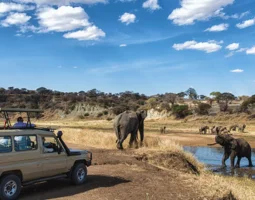
Game Drive Adventure
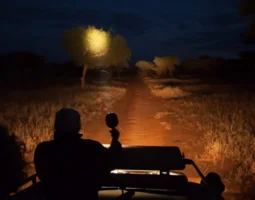
Night Drive Thrills
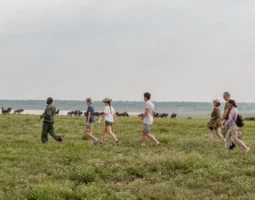
Walking Safari Exploration
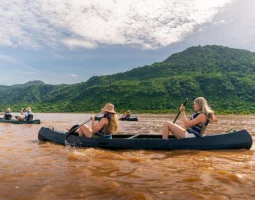
Canoeing Lake Serenity
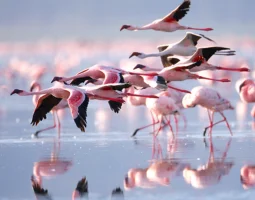
Bird Watching Haven
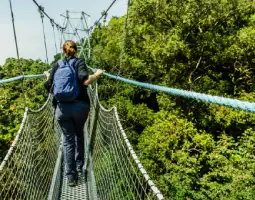
Canopy Walk Views
See Lake Manyara Close-Up
Build your perfect Lake Manyara adventure with us. Choose from bespoke safari options that let you explore wildlife, canoe, or walk high among the treetops on your terms.
Craft your unique Lake Safari!
Safari Packages
Create Your Dream Journey
Personalize your itinerary or choose from our curated travel experiences.
Talk to a Travel Expert
Receive expert advice to plan your ideal adventure with confidence.
Explore Tanzania with Us
Best Safari Packages In One Place
Arusha, Tanzania
Duration: 10 Days
Experience: Birding Safari
Price: On request
Arusha, Tanzania
Duration: 7 Days
Experience: Honeymoon Safari
Price: On request
Arusha, Tanzania
Duration: 16 Days
Experience: Birding Safari
Price: On request
Arusha, Tanzania
Duration: 13 Days
Experience: Northern Circuits
Price: On request
Arusha, Tanzania
Duration: 8 Days
Experience: Wildbeest Migration
Price: On request
Arusha, Tanzania
Duration: 21 Days
Experience: Best of Tanzania
Price: On request
Arusha, Tanzania
Duration: 10 Days
Experience: Maximum Wilderness
Price: On request
Why travel With Sumbi Extra Miles Safari?
LOCAL KNOWLEDGE
Our guides share local culture and hidden treasures because they are intimately familiar with Tanzania. A wonderful and genuine safari experience is guaranteed when you travel with a crew that is well-versed in every aspect.
TAILORED TRIP PLANS
Every trip is designed to fit your interests and travel style. Our personalized arrangements guarantee that you get the most out of your vacation, whether your goal is adventure or leisure.
ECO CONSCIOUS APPROACH
To preserve Tanzania's natural beauty, we place a high priority on sustainable methods. By selecting us, you contribute to responsible tourism and conservation initiatives, protecting wildlife and natural areas for coming generations.
All You Need to Know for Lake Manyara Safari Travel
Getting to Lake Manyara National Park
Starting your journey to Lake Manyara National Park is simple and scenic, especially if you’re coming from Arusha, the hub for Tanzania’s Northern Safari Circuit.
It’s a smooth two-hour drive from Arusha along the A104 road, perfect for visiting Lake Manyara and nearby parks like Ngorongoro or Tarangire.
Drive from Arusha
The drive covers about 78 miles and offers a chance to see the beautiful Tanzanian landscape on your way to the park.
Flights to Lake Manyara
You can also take a quick 30-minute flight from Arusha to Lake Manyara Airport. Small planes from companies like Auric Air and Coastal Aviation fly there every day, giving you amazing views from the air.
Once you arrive, you’re just steps away from exploring the diverse wildlife and beautiful scenery at Lake Manyara. Thus, whether by road or air, getting there is part of the fun and kicks off an exciting Safari in Tanzania with us.
Lake Manyara National Park Entrance Fees
Going to Lake Manyara National Park is a big part of any Tanzania safari Itinerary. Knowing the entry fees helps you plan your visit better.
Adult Visitors from Other Countries
$50 per person in the busy season and $45 in the quieter times, not including an 18% tax.
Kids (ages 5-15)
They pay $15 when it’s busy and a bit less when it’s not.
Residents and People Living in Tanzania
Adults pay $25 in the busy season and $22.5 in the off-season. Kids pay $7.5.
East African Citizens
Adults pay 10,000 Tanzanian Shillings and kids pay 2,000.
Children below 5 years
Irrespective of their residency status, children below 5 years are exempted from any Lake Manyara National Park Entrance Fees.
These fees help take care of Lake Manyara so you can enjoy seeing the animals and nature. These costs make sure the park stays beautiful and safe for everyone.
Getting Around Lake Manyara National Park
Lake Manyara National Park in Tanzania is easy to explore, and you can choose from several fun ways to see everything it offers:
Driving
Most visitors drive from Arusha, which takes about two and a half hours. The park’s roads are in great shape, making it easy for anyone new to driving on safaris.
Flying
You can also fly into the park. Planes from Kilimanjaro International Airport or Arusha Airport go to Manyara Airstrip. This quick trip is often part of Luxury Tanzania Safari packages.
Walking
For a close-up adventure, walk the park’s trails like the treetop walkway and Majimoto Trail. These paths let you see the park’s animals and birds up close.
So, irrespective of whether you drive, fly, or walk, Lake Manyara offers beautiful sights and sounds. Let our team of experts help you plan the best way to see all the park’s wonders in a way that suits you best.
Weather & Climate
The climate at Lake Manyara National Park offers warmth and consistency throughout the year, making it a comfortable destination at any time. Here’s a simple guide to help you gain some understanding about the Best Time to Visit Tanzania for Lake Manyara Safaris.
General Climate
Lake Manyara enjoys mild weather, with daytime temperatures steady around 26°C/79°F. Mornings and evenings can get cool, so packing some warm clothes for early game drives is wise, especially from June to September.
Lake Manyara’s dry season runs from June to October. The wet season includes two rainy periods: short rains from November to December and long rains from March to May, with a dry break in between. It usually doesn’t rain all day.
Dry Season (June to October)
Expect sunny days with little to no rain, ideal for wildlife viewing.
- June to September: Afternoons are warm, and nights can cool down to around 14°C/57°F.
- October: Early rains might start, adding a fresh layer to the dusty landscape.
Wet Season (November to May)
Warmer overall, with occasional showers that rarely disrupt a full day’s plan.
- November & December: Short rains refresh the park without much disruption to safari activities.
- January & February: Enjoy a dry spell between the rainy seasons, perfect for extended game drives.
- March to May: Long rains bring daily showers, lush landscapes, and abundant birdlife.
For Lake Manyara Safaris, any time can be rewarding, but if you enjoy vibrant green landscapes and fewer crowds, the wet season could be uniquely appealing—book with us to experience the best of Lake Manyara in comfort and style.
Where to Stay During Lake Manyara Safaris?
When visiting Lake Manyara National Park, you’ll find plenty of accommodation options to fit any budget. Choices range from campsites and bandas (simple brick cabins with thatched roofs) to tented camps and lodges.
The only lodge inside the park is the AndBeyond Lake Manyara Tree Lodge, famous for its stunning treehouse-style suites. Guests can also enjoy unique experiences like night safaris and a private canopy walkway for exploring the forest.
For those looking to stay outside the park but still nearby, there are several great options:
- Lake Manyara Kilimamoja Lodge is a luxurious lodge offering beautiful views of the landscape.
- The Plantation Lodge is known for its elegant charm and peaceful surroundings.
- Escarpment Luxury Lodge features private chalets with stunning views and wildlife right from your balcony.
- Manyara Serena Safari Lodge offers a blend of comfort and traditional African design with unforgettable experiences.
With so many options to choose from, you’re sure to find a perfect stay that suits your style and budget while enjoying your Lake Manyara safari.
What to Wear on Lake Manyara Safari?
When planning your safari in Lake Manyara National Park, it’s important to dress smart to stay comfortable and protected. Since mosquitoes and tsetse flies can be a problem, wearing long pants and long-sleeved shirts is a good idea. You should also bring insect repellent to help keep bugs away.
Here’s a simple guide for What to Wear on A Tanzania Safari to Lake Manyara:
- – Long pants and shirts protect your skin from bites.
- – Sturdy and comfortable shoes will keep your feet safe while walking on the trails.
- – The sun can be strong, so it’s best to wear a hat and shades.
- – Light, neutral-coloured clothes help you stay cool and blend into the natural surroundings.
By packing these items, you’ll be well-prepared to enjoy your Tanzania safari in comfort and safety.
Lake Manyara Health & Safety
Lake Manyara National Park in Tanzania is known for being safe and full of beautiful wildlife. People come here to enjoy a calm and secure safari in one of Tanzania’s most beautiful places.
- – You can see elephants, giraffes, and lots of birds here. Always watch animals from a safe distance and listen to your guide to stay safe.
- – There are many mosquitoes in this area, so it’s important to use bug spray and wear long shirts and pants in the early morning and evening to protect yourself.
- – Talk to your doctor about getting shots for diseases like yellow fever before your trip. This is important for staying healthy on your safari.
- – While Tanzania Travel Safety is good, remember to take care of your things and choose safe ways to travel, especially in busy places near the park.
Visiting Lake Manyara National Park is a great adventure if you’re ready. With us as your travel partner, you’ll have a safe and exciting trip to see some of Tanzania’s most amazing sights. Being well-prepared makes your visit smooth and fun.
Extra Tips
We have outlined all the extra tips you will ever need for the best possible Lake Manyara Safari experience in the points below:
- – Remember, it gets hot during the day but chilly in the morning and evening. Pack some long-sleeve shirts to keep cosy during those early safari rides.
- – You can spot animals like elephants and lions all year round, but the dry season from June to October is the best time for watching wildlife. This time coincides with the Best Time to Visit Tanzania.
- – If you’re into birds, come between November and April. This is when lots of birds, including flamingos, hang out by the lake.
- – The park has two rainy seasons. One is from November to December and the other from March to May. These times are perfect if you want to see the lake full and the birds looking their best.
With Sumbi Extra Miles Safari, your adventure will be super fun and safe. Pack all your travel essentials, pick a good time to visit, and get ready for an amazing experience!








